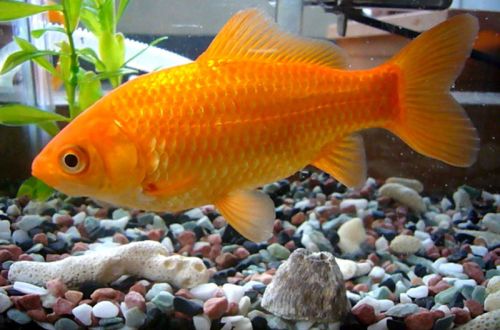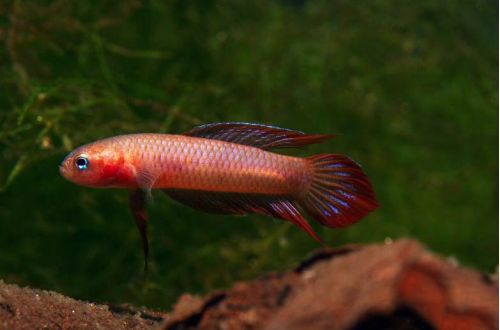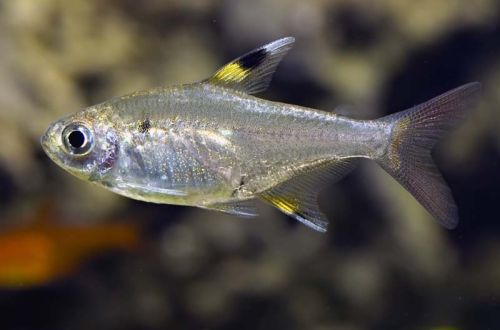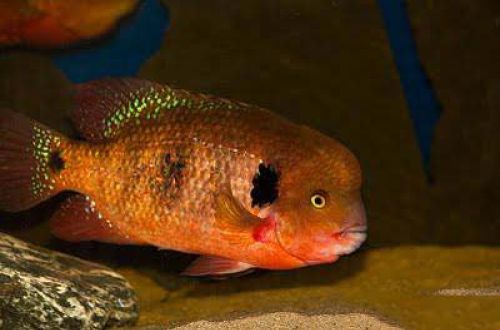
Goldfish
The Common Goldfish, scientific name Carassius auratus, belongs to the Cyprinidae family. The most famous and widespread of modern aquarium fish. Such a high popularity is due not only to external beauty, but also to incredible endurance. It is easy to keep, it is not picky about food, it eats everything that is offered. Goldfish quickly adapt to almost all aquariums, are compatible with many types of peaceful fish.

The Common Goldfish is often confused with the Comet, one of the breeding varieties of the species. Both fish have the same body shape, but in the latter, the fins, especially the tail, are much larger, and the tail is more forked. In addition, the colors of the Comet are closer to the reddish-orange spectrum, the Goldfish is more orange.
Another very similar variety, which is also often confused with, is the Shubunkin. In terms of the shape and size of the fins, they are identical, but the Shubunkin has a completely different coloration, it can be spotted or have a different variegated color scheme.
All three forms are close relatives to their ancestor, therefore they are distinguished by endurance and the ability to endure significant temperature changes. Due to these features, fish are used in open reservoirs, poods.
Habitat
Modern Goldfish are descendants of the wild cyprinid fish known as the Prussian carp, crucian carp or Doom carp (Carassius gibelio). Fish originate from the reservoirs of Central Asia, Siberia, live in slowly moving and stagnant waters of rivers, lakes, ponds. They feed on plants, detritus, small crustaceans and insects.
At the beginning of the 16th century, these fish were first exported to Japan and China, where they served as decorations for the imperial gardens. In the era of the heyday of the colonial system, Goldfish ended up in Europe, it was from that time that a breeding boom began. Currently, more than 125 varieties/cultivars are known.
Description
The body shape is somewhat elongated, tapering towards the tail. The head is large and wide. The caudal fin is bifurcated, the dorsal fin is slightly curved. The color is predominantly orange or yellow (gold).
The size of the fish can vary considerably, determined mainly by the size of the tank. In a small aquarium (100 liters) it reaches 10 cm or more, and in a pond it grows up to 30–35 cm. The average life expectancy is 10–15 years. However, specimens living 20 years or more are not uncommon if kept in good aquarium and pond conditions.
Food
They belong to omnivorous species, accept all types of dry (flakes, granules, tablets), frozen, live food. It is worth remembering that live food carries the risk of infecting fish with various parasites, so it is recommended to use frozen meat products. There is a wide range of specialized foods designed for feeding Goldfish, which include all the necessary vitamins and minerals.
Maintenance and care
Goldfish produce a fairly large amount of waste, while requiring a high oxygen content in the water. In turn, organic waste reacts very quickly with oxygen, reducing its amount. Given these features, you should choose a spacious tank with a large surface area. The optimal is a rectangular aquarium from 40 liters for one fish, for each subsequent one, +10 liters should be added. Thus, in an aquarium of one hundred liters, no more than 7 specimens should be contained. If you get a round tank, then you should not fill it completely, the largest surface area of u3bu4bthe water is in the middle, so a XNUMX/XNUMX ratio will be optimal.
A weekly replacement of part of the water (about 25% of the volume) and the installation of a productive filter will help to cope with waste. However, it can be completely dispensed with if the aquarium contains only one or two fish. A lighting system and an aerator are desirable, but a heater will be superfluous, the fish are able to live at room temperature. Moreover, Goldfish successfully endure temperatures slightly above zero, if it drops gradually, by several degrees a day.
Design according to your taste, but taking into account a few tips: plants must be with a strong root system, otherwise they can be torn out; decor items (stones, driftwood, grottoes, etc.) should not have sharp edges. Plants should be chosen from cold-water species.
Social behavior
Very peaceful, compatible with most other friendly calm fish. Able to live both alone and in a community of one or more species. Excellent neighbors are obtained from other varieties of Goldfish.
Breeding / breeding
Breeding at home is quite simple. Since sex differences are not very pronounced, it is necessary to acquire several fish to guarantee spawning. Spawning can be done in the main aquarium, it is desirable to use the Brazilian Elodea plant in decoration, it tolerates low temperatures, produces a large amount of oxygen and serves as a shelter for fry.
The stimulus for the mating season is a gradual decrease in temperature to 11–12 ° C for a couple of days, and then a gradual alignment with the room temperature. This is a fleeting imitation of natural conditions, when the temperature fluctuates with the arrival of spring in the middle lane. Meat products must be added to the daily diet. During the rise in temperature, the male begins mating courtship, pursues the female throughout the aquarium, and invites her into the thickets of plants. This behavior can last for several days, then spawning occurs. In 2–3 hours, up to 10 thousand eggs are produced, which are attached to plants with the help of adhesive threads.
Parents do not care about offspring and can eat eggs, so plants with eggs are recommended to be placed in a separate tank, for example, a three-liter jar filled with water from the main aquarium. At first, the fry are colored dark brown or black, masking them in plants, natural colors appear after a few months. When they grow up to 2–3 cm in length, they can be transplanted to their parents. Feed with specialized feed for fry.
Breeding Goldfish
Diseases
In a balanced aquarium with a well-established biological system and good nutrition, health problems are not observed. However, contact with sick fish, the introduction of contaminated live food, relocation, etc. triggers disease outbreaks. Read more about symptoms and treatments in the Aquarium Fish Diseases section.





